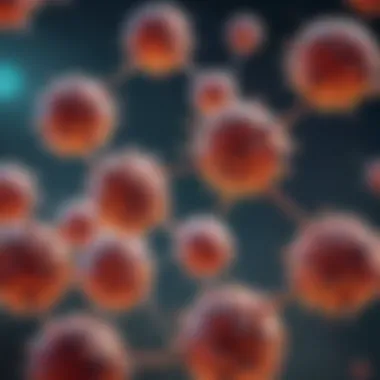Role of Anti-CD55 Antibodies in Cancer Immunotherapy


Intro
In the realm of immunotherapy, there exists a growing interest in various biological targets, and anti-CD55 antibodies stand out prominently. These antibodies have begun to capture attention for their remarkable potential in modulating immune responses, particularly in cancer treatment. Understanding the intricacies surrounding CD55 is essential as it plays a pivotal role in regulating the complement system. This gives rise to a complex interplay between tumor immunity and immune evasion.
Researchers and healthcare professionals are increasingly focused on how anti-CD55 antibodies can be harnessed to enhance therapeutic protocols. This article aims to provide an in-depth exploration of anti-CD55 antibodies, shedding light on their mechanisms of action, recent studies, and applications in treating various malignancies. By bridging complex scientific research with accessible information, it strives to empower researchers, educators, and professionals in navigating the evolving landscape of antibody-based therapies.
Key Concepts
Definition of the Main Idea
Anti-CD55 antibodies are a unique class of therapeutic agents designed to target CD55, a glycoprotein commonly expressed on the surface of both normal and malignant cells. This protein helps cells evade the immune system by binding to complement proteins, thus preventing the formation of the membrane attack complex. Consequently, when CD55 is inhibited through these antibodies, it can potentially enhance the immune system's ability to recognize and eliminate tumor cells.
Overview of Scientific Principles
The complement system is part of the innate immune response and works as a defense mechanism against pathogens and infected cells. It operates through a series of proteins that facilitate opsonization and lysis of targeted cells. CD55, otherwise known as decay-accelerating factor, regulates this system by cleaving complement components and obstructing the ongoing immune response. Understanding its biological mechanism is crucial as it lays the groundwork for developing effective anti-CD55 therapies, which aim to amplify immune response against tumors.
"A deeper dive into anti-CD55 antibodies reveals how targeting immune evasion mechanisms holds great promise for novel cancer therapies."
"A deeper dive into anti-CD55 antibodies reveals how targeting immune evasion mechanisms holds great promise for novel cancer therapies."
Current Research Trends
Recent Studies and Findings
Recent research has illuminated the potential of anti-CD55 antibodies in various therapeutic contexts. For instance, studies have indicated that these antibodies can enhance the effectiveness of existing therapies, such as chemotherapy and checkpoint inhibitors, by preventing tumors from exploiting CD55-mediated immune evasion. Clinical trials are ongoing to evaluate the safety and efficacy of these therapies in different cancer types, with promising preliminary results.
Significant Breakthroughs in the Field
Several noteworthy advancements have been observed in the field. Key breakthroughs include:
- The identification of specific antibody formats that maximize binding affinity to CD55.
- Emerging evidence showcasing synergy when anti-CD55 antibodies are combined with other immunotherapies, enhancing overall response rates.
- Developments in understanding the role of CD55 in other diseases beyond cancer, such as autoimmune disorders and cardiovascular diseases.
Engaging with the intricate details of CD55 functions provides a broader understanding of potential therapeutic advantages. As research progresses, the landscape of anti-CD55 antibodies appears more promising, indicating a significant shift in immunotherapeutic strategies.
Prolusion to Anti-CD55 Antibodies
Anti-CD55 antibodies represent a critical area of research in the field of immunotherapy, especially as scientists and clinicians relentlessly seek out innovative ways to combat diseases like cancer. By targeting CD55, a glycoprotein that acts as a natural regulator of the complement system, these antibodies hold the promise of influencing how the immune system interacts with tumors. This introduction lays the groundwork for understanding both the significance of CD55 in human health and the vital role that its antibodies can play in therapeutic contexts.
Overview of CD55 Function
CD55, also known as decay-accelerating factor (DAF), plays a multifunctional role in maintaining homeostasis within the immune system. Its primary function is to inhibit the complement pathway, thereby preventing cellular lysis. Essentially, CD55 serves as a protective shield for healthy cells against the immune cascade that could lead to unwanted cell death. However, in the context of cancer, this characteristic becomes a double-edged sword. Tumor cells often exploit CD55 to evade detection and destruction by immune cells, which significantly hampers effective anti-tumor responses.
In terms of mechanics, CD55 binds to complement proteins, effectively disarming the complement-mediated attack that could otherwise eradicate malignant cells. Thus, the presence of CD55 on a tumor surface is akin to a covert agent, working diligently to ensure the tumor remains unchecked. Consequently, the use of anti-CD55 antibodies aims to disrupt this interaction, lifting the veil of protection and allowing the immune system a fighting chance.
Historical Context of Anti-CD55 Research
The exploration of anti-CD55 antibodies has evolved over decades, bridging fundamental immunology with practical therapeutic applications. Initially, research focused on the fundamental understanding of CD55’s role in complement regulation. Only later did the scientific community begin to recognize the implications of CD55 in tumor biology. Early studies hinted at its potential to bestow an immune evasive cloak on neoplasms, thus setting the stage for a deeper investigation into how targeting this protein could yield a new method of intervention.
Over the years, researchers have ventured into various approaches, from monoclonal antibodies to newer technologies like antibody-drug conjugates. Each path paved the way for heightened understanding and novel hypotheses regarding not just cancer, but autoimmune diseases as well. While much of this exploration has been rooted in laboratory settings, recent advancements in clinical trials signal a shift, as researchers aim to translate bench-top discoveries to bedside treatments.
The historical trajectory of anti-CD55 research underscores both the complexity and promise of such therapies. This backdrop enables us to appreciate the unfolding narrative of anti-CD55 antibodies, as they transition from intriguing scientific concepts to viable treatment options in the clinic.


Biological Mechanisms of Anti-CD55 Antibodies
Understanding the biological mechanisms of anti-CD55 antibodies is crucial when discussing their role in immunotherapy. These mechanisms not only highlight how these antibodies function but also underscore their therapeutic potential in various diseases, especially cancer. CD55, being a critical regulator of the complement system, modulates immune response and tumor behaviors.
Interaction with the Complement System
The interaction between anti-CD55 antibodies and the complement system stands as a cornerstone in their mechanism of action. CD55 helps protect cells from being attacked by the complement system, which usually functions to eliminate pathogens. Essentially, it inhibits complement activation, thereby enabling some tumor cells to evade immune detection.
When anti-CD55 antibodies bind to CD55, they can block this protective interaction. This action can trigger complement-dependent cytotoxicity, where the complement system is unleashed against malignant cells. By preventing CD55 from doing its job, antibodies pave the way for a potent immune response, allowing immune cells to identify and destroy tumor cells. The clinical significance of exploiting this interaction is apparent, as re-establishing complement activity can enhance the efficacy of existing therapies and potentially lead to better outcomes.
"The complement system is not just part of innate immunity, but a crucial ally when we think of using anti-CD55 antibodies."
"The complement system is not just part of innate immunity, but a crucial ally when we think of using anti-CD55 antibodies."
Effects on Tumor Microenvironment
The tumor microenvironment can be thought of as a double-edged sword—it can either facilitate or hinder the effectiveness of immunotherapy. Anti-CD55 antibodies can significantly alter this microenvironment. Tumors often create microenvironments that suppress immune responses, encouraging their survival and proliferation. However, by targeting CD55, these antibodies disrupt such protective mechanisms.
When applied, anti-CD55 antibodies lead to a decrease in immuno-suppressive factors and promote a more inflammatory milieu. Tumor-infiltrating lymphocytes often become more active. This enhancement of immune activity is crucial, as it can turn the tide; previously dormant immune responses can become activated, aggressively targeting malignancies. Hence, the ability of these antibodies to modify the microenvironment marks them as potential game changers in therapeutic strategies.
Modulation of Immune Response
The primary goal of immunotherapy is to harness and amplify the body's immune response against diseases like cancer. Anti-CD55 antibodies play an indispensable role in this process through their modulation capabilities. By interfering with CD55's function, they enhance the activation and proliferation of effector T cells, which are critical in confronting tumors.
In essence, these antibodies enable the immune system to “see” the tumor more clearly, facilitating a targeted attack. Moreover, they can help in overcoming resistance mechanisms that many tumors develop against therapies. This capability makes anti-CD55 antibodies not just an additional tool in the immunotherapy toolbox, but rather a strategic asset in the ongoing battle against tumors.
In summary, the biological mechanisms through which anti-CD55 antibodies function provide critical insights. They interact with the complement system, alter the tumor microenvironment, and effectively modulate immune responses. As research progresses, understanding these intricate details will help unlock even more therapeutic potential.
Therapeutic Applications of Anti-CD55 Antibodies
The therapeutic landscape of anti-CD55 antibodies presents a compelling frontier in immunotherapy, one that could dramatically shift current treatment paradigms. Their unique mechanism of action provides a multi-faceted approach to treating various diseases, particularly cancers, autoimmune disorders, and even some infectious diseases. This section examines these applications, underscoring the significant benefits, potential risks, and gaps that remain in our understanding and application of these antibodies.
Role in Cancer Treatment
Cancer treatment has long been a juggernaut of medical research, with a constant push towards finding innovative avenues to enhance efficacy and minimize side effects. Anti-CD55 antibodies play a pivotal role in this domain by targeting CD55's ability to inhibit complement-mediated cytotoxicity. In simpler terms, CD55 usually acts as a guard, protecting tumor cells from being destroyed by the body's own immune system. By inhibiting this protective mechanism, these antibodies may allow the immune system to better recognize and eradicate cancerous cells.
Recent studies show that the use of anti-CD55 antibodies can synergize with other therapies, like checkpoint inhibitors, creating a robust attack on tumors. In clinical trials, combinations of these antibodies with traditional therapies such as chemotherapy and radiation have shown improved outcomes in patients with various malignancies, including pancreatic and ovarian cancers. Thus, the introduction of anti-CD55 antibodies may not only enhance survival rates but also offer hope where options once seemed bleak.
Applications in Autoimmune Diseases
While cancers take the lion's share of attention, autoimmune diseases represent another significant area where anti-CD55 antibodies could be game-changers. Autoimmune conditions occur when the body mistakenly attacks its own cells, a process that CD55 can aggravate by preventing necessary immune responses. By blocking CD55, anti-CD55 antibodies may help restore balance to the immune system, potentially attenuating the hyperactive immune responses seen in diseases like lupus or rheumatoid arthritis.
Clinical investigations into this aspect are in their infancy, but curiosity is high. Early findings indicate that therapies targeting CD55 could lead to significant improvements in the quality of life for individuals afflicted by these chronic conditions. With a proper understanding, these antibodies could become a cornerstone in the management of autoimmune diseases, providing an alternative route to control symptoms and improve patient outcomes.
Potential in Infectious Diseases
Interestingly, the applicability of anti-CD55 antibodies is not confined to cancer and autoimmune diseases. Emerging research hints at their potential role in infectious diseases, particularly those orchestrated by pathogens that manipulate the immune response. Certain viruses, for instance, have been known to exploit the CD55 pathway to evade destruction. By employing anti-CD55 antibodies, it may be possible to weaken this evasion tactic, rendering the virus more susceptible to the immune system's attacks.
This approach holds promise in treating a variety of infectious diseases, including those caused by common viruses or even complex pathogens like HIV. While still in the exploratory phases, the intersection between anti-CD55 therapy and infectious diseases could pave new avenues for effective treatments.
Embracing anti-CD55 antibody therapies could significantly influence the therapeutic landscape, offering avenues that were once thought nearly impossible.


Embracing anti-CD55 antibody therapies could significantly influence the therapeutic landscape, offering avenues that were once thought nearly impossible.
As we chart the future of these applications, it is paramount to critically assess not only the benefits but also the implications of introducing such treatments into clinical practice.
Through innovations and dedicated research, anti-CD55 antibodies could soon find their place in the therapeutic arsenal, benefiting countless individuals across various spectrums of health.
Current Research Landscape
The landscape of research surrounding anti-CD55 antibodies is continually evolving, driven by innovations in immunotherapy and a deeper understanding of the immune system. The role these antibodies may play in treating various conditions, particularly cancers, is gaining traction in scientific discussions and clinical settings alike. This section elaborates on the ongoing investigations and their implications, highlighting both the advancements achieved and the hurdles that remain.
Clinical Trials Involving Anti-CD55 Antibodies
Clinical trials serve as the backbone of medical advancements, particularly in the field of immunotherapy. They offer a structured approach to assess the therapeutic value of anti-CD55 antibodies. Several trials are underway to gauge their effectiveness against numerous malignancies, from melanoma to renal cell carcinoma. Here are some key points regarding these trials:
- Phase I Trials: Focus on safety and proper dosing to establish foundational data for further studies.
- Phase II and III Trials: These trials broaden the participant pool to include diverse demographics, shedding light on the antibodies' efficacy across various populations.
- Combination Therapies: There's a growing interest in the synergy between anti-CD55 antibodies and existing treatments like checkpoint inhibitors or chemotherapy, which may enhance overall treatment outcomes.
The necessity of these trials can't be overstated; as checkpoints are evaluated, we can glean insights into how anti-CD55 antibodies can be best utilized within the broader spectrum of cancer therapies.
Key Findings and Progress
As research unfolds, some promising findings have emerged from various studies involving anti-CD55 antibodies:
- Enhanced Tumor Suppression: Preliminary results indicate that anti-CD55 antibodies may directly impede tumor growth by reducing the ability of cancer cells to evade immune detection.
- Role in Immune Activation: Observations suggest that these antibodies may boost immune responses, leading to increased T-cell activation and proliferation in tumor environments.
- Biomarker Development: Efforts to identify biomarkers associated with response to anti-CD55 therapies could tailor treatments to individual patient profiles, enhancing the precision of immunotherapies.
"The journey of research is fraught with challenges, but also paved with the potential to ignite significant breakthroughs in cancer care through innovative antibody therapies."
"The journey of research is fraught with challenges, but also paved with the potential to ignite significant breakthroughs in cancer care through innovative antibody therapies."
Despite the progress, several challenges loom large. Issues of immunogenicity, variability in patient responses, and regulatory concerns tend to add complexity to the translation of these findings into standard clinical practice. Nevertheless, with increased funding and collaboration among researchers, the future for anti-CD55 antibody development looks promising.
In summary, understanding the current research landscape surrounding anti-CD55 antibodies offers critical insights into their therapeutic potential. By examining ongoing clinical trials and synthesizing key findings, researchers and practitioners together can elevate care standards in personalized medicine for patients facing tough battles against cancer and beyond.
Challenges and Limitations
The journey of developing anti-CD55 antibodies in immunotherapy is far from a smooth ride. Acknowledging the challenges and limitations associated with these therapies is crucial for advancing effective treatments. This section aims to shed light on some key aspects that researchers, healthcare professionals, and stakeholders need to consider while navigating this promising yet complex landscape.
Immunogenicity of Antibody Therapies
One of the foremost challenges with anti-CD55 therapies is their immunogenicity. Unlike monoclonal antibodies that mimic human proteins, some of these therapies may invoke an immune response due to their foreign structures. This can lead to the production of anti-drug antibodies (ADAs), potentially reducing the efficacy of treatment. For instance, studies have shown that patients can develop ADAs against certain monoclonal antibodies, which may result in treatment failure or adverse reactions. The frequency and variability of immune responses among patients can complicate the therapeutic landscape.
"Immunogenicity is a double-edged sword; it can mean potential efficacy, but also increased risk of adverse effects."
"Immunogenicity is a double-edged sword; it can mean potential efficacy, but also increased risk of adverse effects."
To mitigate this, researchers are exploring humanization techniques for antibodies to make them less recognizable to the immune system. Another avenue of exploration lies in the combination of anti-CD55 antibodies with immunosuppressive agents, aiming to lower the immune system's response. Only through careful design and testing will the full potential of these therapies be realized.
Efficacy in Diverse Patient Populations
A significant aspect influencing the success of anti-CD55 therapies is their efficacy across diverse patient populations. Variability in genetic backgrounds, lifestyle, and even co-morbidities can affect how individual patients respond to treatments. For example, cancer heterogeneity can mean that even within the same type of tumor, the expression of CD55 may vary significantly. This creates a conundrum—one size does not fit all.
Moreover, clinical data show that certain demographics, such as older adults or those with multiple health concerns, may not respond as robustly as younger, healthier patients. Thus, understanding the biomarkers that predict response is paramount.


To tackle these issues, personalized medicine is emerging as a crucial approach, allowing therapies to be tailored effectively based on patients’ unique profiles.
Regulatory and Developmental Hurdles
The path to bringing anti-CD55 antibodies from the lab to clinics is riddled with regulatory and developmental hurdles. Although there has been significant progress, the road can be long. Regulatory bodies like the FDA or EMA require extensive clinical trial data to ensure that these therapies are both effective and safe. This includes not only efficacy data but also long-term safety studies that can span years.
Furthermore, industry players must engage in transparent reporting and communication with these agencies. Any discrepancies in data reporting can lead to significant delays in approval processes.
Regulatory guidelines are also in a state of constant flux, thus keeping up with these changes is essential for research teams. The complex protocols and documentation required for trial approval, like investigational new drug applications, can act as chokepoints, delaying the milestone of clinical adoption.
In summary, while the potential for anti-CD55 antibodies in immunotherapy is promising, substantial challenges remain. Addressing immunogenicity, ensuring efficacy across varied populations, and navigating the regulatory maze will require focused research efforts and innovative approaches. These barriers only serve to highlight the importance of continuing support for research in this area, paving the way to enhance patient outcomes in the future.
Future Directions in Research
The exploration of future directions in research regarding anti-CD55 antibodies is not just a continuation of existing studies; it represents a pivotal shift in our approach to immunotherapy. As our understanding of the immune system deepens, the necessity for innovative strategies to harness the full potential of anti-CD55 antibodies becomes more apparent. Researchers are now on the lookout for ways to enhance the efficacy, specificity, and tolerance of these therapies. Following are key elements that will shape future studies in this domain.
Innovative Approaches to Antibody Development
One key focus for the future is the development of next-generation antibodies. Current anti-CD55 antibodies often face challenges regarding potency and specificity. To tackle this, researchers may explore various innovative methods such as:
- Bispecific antibodies: These engineered antibodies can simultaneously bind to two different antigens, potentially targeting both CD55 and another tumor-specific antigen, thus increasing treatment efficiency.
- Antibody-drug conjugates (ADCs): By linking anti-CD55 antibodies to cytotoxic drugs, researchers can create targeted therapies that minimize damage to healthy tissues while effectively killing cancer cells.
- Nanobodies: These smaller, single-domain antibodies are easier to produce and may offer higher stability and better tissue penetration than traditional antibodies.
Additionally, there is a substantial interest in utilizing machine learning algorithms and bioinformatics to design antibodies with enhanced pharmacokinetic and pharmacodynamic properties. This blend of innovative technologies not only could optimize the design but may also reduce the trial and error common in traditional drug development.
Personalized Medicine and Anti-CD55
The era of personalized medicine is upon us, and anti-CD55 antibodies have significant potential in tailoring therapies to individual patients. Recent advances in genomics and proteomics allow for more precise patient stratification. Underpinning this movement is the emphasis on understanding the specific tumor microenvironments of patients. Factors to consider include:
- Biomarker identification: Identifying biomarkers that predict response to anti-CD55 therapies is essential. This can include not only the expression levels of CD55 but also related signaling pathways that may be activated in specific cancers.
- Adaptive treatment strategies: Personalized medicine encourages a shift towards adaptive therapies where treatment protocols can be adjusted based on ongoing patient response, maximizing efficacy while minimizing adverse effects.
- Combination therapies: The integration of anti-CD55 antibodies with immunotherapeutic agents, targeted therapies, or checkpoint inhibitors can be combed to enhance overall treatment success. Distinct patient profiles allow for unique combinations that could lead to better outcomes.
"The future is not something we enter. The future is something we create."
– Leonard I. Sweet
"The future is not something we enter. The future is something we create."
– Leonard I. Sweet
Embracing the concepts of personalized medicine within the framework of anti-CD55 antibodies may not only improve the outcomes in oncology but also expand their use in non-cancerous ailments like autoimmune diseases. Advances in understanding patient-specific immune profiles could redefine how these therapeutic agents are implemented.
In summary, the future of research surrounding anti-CD55 antibodies going forward is bright. The focus on innovative antibody developments combined with the tailored approach of personalized medicine represents a concerted effort to enhance patient care and treatment outcomes on a global scale.
Finale
Summary of Key Insights
The investigation of anti-CD55 antibodies highlights pivotal aspects concerning their therapeutic potential, particularly in the realm of immunotherapy. Firstly, these antibodies serve as critical modulators of the complement system, which is essential for orchestrating immune responses against tumors. Understanding the complexities of CD55 function and its interplay with immune mechanisms elucidates the potential pathways for therapeutic intervention. Various studies have shed light on how anti-CD55 antibodies not only challenge immune evasion strategies employed by tumors but also positively impact the tumor microenvironment, leading to greater immune responsiveness.
Moreover, therapeutic applications extend far beyond oncology, reaching into autoimmune diseases and possibly infectious diseases, which underscores the versatility of such antibodies. Therefore, synthesizing the findings from recent clinical trials and preclinical studies is vital to gauge the full spectrum of the efficacy and safety profiles associated with these treatments.
The Path Forward for Anti-CD55 Antibodies
In contemplating the future of anti-CD55 antibody research, several dynamic considerations come into play. Innovative approaches to antibody development are emerging, utilizing advanced biopharmaceutical techniques to enhance efficacy. For instance, novel methods like bispecific antibodies are gaining traction, potentially allowing for simultaneous targeting of multiple immune pathways.
Furthermore, the evolution toward personalized medicine holds significant promise. Leveraging genomic and proteomic data could lead tailored therapies that resonate with individual patient profiles, optimizing treatment outcomes. Collaborative efforts amongst scientists, clinicians, and regulatory bodies will undoubtedly yield expansive insights into best practices and the regulatory framework necessary to facilitate these advancements.
"The success of anti-CD55 therapies may well hinge on our ability to integrate multidimensional data, pushing the boundaries of traditional therapies to new paradigms of treatment."
"The success of anti-CD55 therapies may well hinge on our ability to integrate multidimensional data, pushing the boundaries of traditional therapies to new paradigms of treatment."
Overall, as we advance in this field, a focus on rigorous clinical trials and real-world data collection will help establish the role of anti-CD55 antibodies in standard therapy protocols, making strides in patient care and outcomes.







